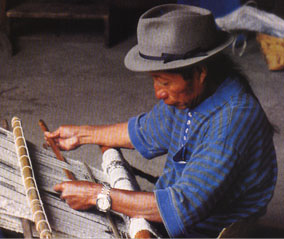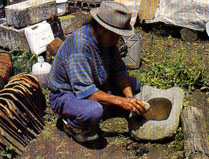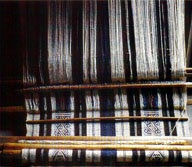
Text and photos: Cheryl Musch
Miguel Andrango sits on a woven reed mat on a concrete floor, his feet pressed against a log to pull the tension on his backstrap loom taut. The loom is an assortment of wooden sticks and string heddles attached to a post of his house and wrapped around his back with a strap made of animal skin. He's weaving a wall hanging in cream and rich brown colors. He concentrates on his work; the warp-faced designs are produced largely with a pick-up technique. Inattention due to conversation produces errors which must be undone.

The tradition of weaving on a backstrap loom in the Andean highlands of northern Ecuador is slowly dying. For centuries before the Spanish conquest, weavers in the Otavalo valley had only backstrap looms. The Spanish introduced the upright treadle loom in the sixteenth century and set up obrajes--early textile production centers--in order to exploit Indian labor. Over the centuries, the Quichua Indians of Otavalo have capitalized on their weaving skills, making them one of the most economically successful indigenous groups in the Americas. Every day woven goods for sale fill the plaza in Otavalo, and on Saturdays this internationally-known market becomes flooded with activity as tourists pour into town to buy woven wall hangings, rugs, bags, sweaters and other items. Nearly all of these products and others for export are now handwoven on upright looms or produced on power looms in villages in the Otavalo valley.

Of the 40,000-50,000 Indians living in this valley, most are involved in some phase of textile production--selling wool, cleaning wool, carding, spinning, dyeing, weaving, sewing, knitting, embroidery, or selling and marketing finished products. Few, however, are devoted full-time to textile production. Small-scale agriculture is an important part of life in the valley, and people continue to farm their land. Near small plots of corn or potato fields in the villages surrounding the town of Otavalo, wool dries near rivers, dyed yarn is tossed over lines, upright looms appear just inside doorways, and the rhythmic clanking of power looms pierces the otherwise pastoral landscape.

In order to revive the ancient art of backstrap weaving, Miguel Andrango and others in Agato, one of the villages outside the town of Otavalo, formed the Tahuantinsuyo Weaving Workshop, which is based in Andrango's house. The members of this cooperative use traditional, natural dyes and weaving designs. The process is more time-consuming than weaving on a treadle loom, consequently Andrango says many young people are not interested in learning backstrap weaving techniques. They prefer instead to make money more quickly with other types of looms or marketing finished products.

Similar to many indigenous families in the Otavalo valley, Andrango's craft was passed through his family. His father, who no longer weaves because of poor eyesight, taught his son to weave on a backstrap loom. In the Otavalo area, textile production depends on the work of the entire family. The Andrango family begins their textile processing by buying raw wool in Otavalo. The wool is shipped from several hours south where there is more land for the grazing of sheep. (Occasionally Andrango uses alpaca wool, which he prefers because it is softer and warmer, and cotton as well.) Children pick out large impurities from the wool, and women wash it in the stream behind the house with liquid from the cabuya plant, which produces a cleansing lather. The wool is carded three times producing roving to be spun on a walking spinning wheel.
Andrango uses wool in its natural colors--white, gray and dark brown--as well as dyeing it with walnut (for dark to light browns), cuchinilla (a female insect which produces dark red or purple), achiote (for yellow and orange), as well as various other plants including eucalyptus leaves (for green-yellow). Synthetic aniline dyes are widely used in Otavalo, and Andrango uses a few chemical dyes for muted colors which are difficult to produce naturally, but he prefers to use natural dyes and colors in his work. The coarse yarn is cooked in the dye over a wood fire in a metal pot. A mordant, usually a type of salt, is added when needed. Once dyed, colored skeins of yarn are hung over a line to dry.

At this point in the process, generally men take over the work, measuring a continuous circular warp on a simple warping board. The board is a flat piece of wood with holes in a line for moveable pegs. Most backstrap weavers warp a single item at a time. The measured warp is slipped off the warping board and onto the loom, to create a piece with four selvedged edges. The weaver alternately lifts a heddle stick and shed stick to pass the weft, integrating designs for borders or of animals by picking up warp threads with his fingers or a stick. Textiles produced on backstrap looms in Otavalo are traditionally warp-faced, with a nearly invisible weft.

The backstrap loom weaver is limited to a width of about three feet. For larger items, like ponchos or blankets, two pieces are sewn together. For the Andrango family, the entire process of creating a blanket takes approximately 240 hours, or the equivalent of eight hours of work every day for a month. Although other parts of textile production involve women, weaving is primarily the domain of men in Ecuador both because of tradition, and as Andrango explains, weaving, especially on a backstrap loom, is hard work. When the piece is removed from the loom, women or girls generally do the finishing work. This division of labor is different in other indigenous groups in Latin America; in Guatemala, for instance, backstrap weaving is definitely women's domain.
As is true of other families in the Otavalo valley, Andrango does not devote himself full time to weaving. The agricultural cycle dictates the amount of time he spends weaving. He weaves less during the planting and harvest seasons, and estimates that in total he spends about fifty percent of his time at weaving and fifty percent in agricultural pursuits.

The members of the Tahuantinsuyo Weaving Workshop sell their products on the second floor of Andrango's home as well as at a nearby hostel. They also do direct exports, avoiding the Otavalo market because they believe middlemen take too large a share of the profits. The quality of the items produced at the workshop is clearly superior to many of the machine-woven products in the market. The time consuming, high-quality work which the cooperative does makes for a more expensive product, but also one with more integrity than the plethora of items produced for tourists. The members of the workshop offer classes in backstrap weaving and hope someday to create a museum to educate the public about traditional textile techniques of the Andes.
Source: "Miguel Andrango," Handwoven, a publication of Interweave Press, September/October 1997, Volume XVIII, No. 4, pp. 50-51.
Web design by Marc Becker, marc@nativeweb.org